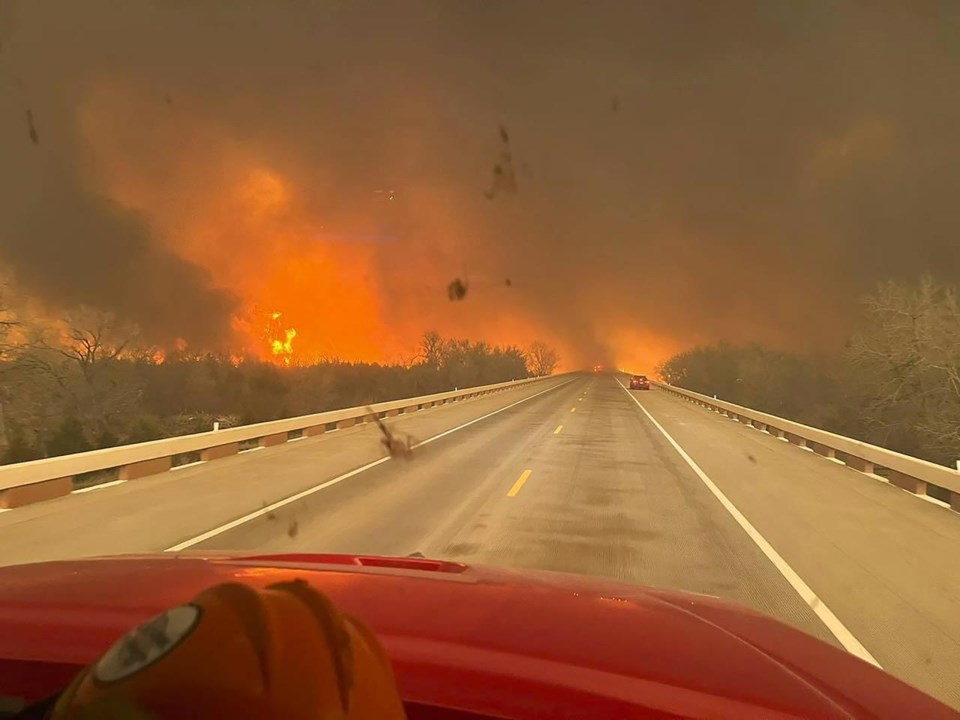CANADIAN, Texas (AP) — A wildfire spreading across the Texas Panhandle became the largest in state history Thursday, as a dusting of snow covered scorched grassland, dead cattle and burned out homes and gave firefighters a brief window of relief in desperate efforts to corral the blaze.
The Smokehouse Creek fire grew to nearly 1,700 square miles (4,400 square kilometers). It merged with another fire and is just 3% contained, according to the Texas A&M Forest Service.
Gray skies from early cloud cover and the snow painted a bleak landscape: miles of blackened grassland, charred houses that still smoldered, dead cattle burned and stiff in the cold. In Stinnett, someone propped up an American flag outside of a destroyed home.
The Smokehouse Creek fire's explosive growth slowed as snow fell and winds and temperatures dipped, but it was still untamed and threatening. It is the largest of several major fires burning in the rural Panhandle section of the state. It has also crossed into Oklahoma.
Authorities said 1,640 square miles (4,248 square kilometers) of the fire were on the Texas side of the border. Previously, the largest fire in recorded state history was the 2006 East Amarillo Complex fire, which burned about 1,400 square miles (3,630 square kilometers) and resulted in 13 deaths.
Firefighters have made little progress taming the Smokehouse Creek blaze, but Thursday’s forecast of snow, rain and temperatures in the 40s offered a brief chance to make progress before temperatures and winds increase again Friday and into the weekend. Authorities have not said what ignited the fires, but strong winds, dry grass and unseasonably warm temperatures fed the blazes.
Less than an inch of snow is expected, but moisture is not the only benefit, said National Weather Service meteorologist Samuel Scoleri.
“It will help keep relative humidity down for the day, and that will definitely help firefighters,” Scoleri said.
An 83-year-old woman was the only confirmed death so far. But with flames still menacing a wide area, authorities have yet to conduct a thorough search for victims or tally the numerous homes and other structures damaged or destroyed.
Nim Kidd, chief of the Texas Division of Emergency Management, said the weekend forecast and “sheer size and scope” of the blaze are the biggest challenges for firefighters.
“I don’t want the community there to feel a false sense of security that all these fires will not grow anymore,” Kidd said. “This is still a very dynamic situation.”
This week, powerful winds pushed walls of flames while huge plumes of smoke billowed hundreds of feet in the air across the sparsely populated region. The smoke delayed aerial surveillance of the damage in some areas.
“There was one point where we couldn’t see anything,” said Greg Downey, 57, describing his escape as flames bore down on his neighborhood. “I didn’t think we’d get out of it.”
The woman who died was identified by family members as Joyce Blankenship, a former substitute teacher. Her grandson, Lee Quesada, said he had posted in a community forum asking if anyone could try and locate her. Quesada said deputies told his uncle on Wednesday that they had found Blankenship’s remains in her burned home.
Quesada said she would surprise him at times with funny little stories “about her more ornery days.”
“Just talking to her was a joy,” he said, adding that “Joy” was a nickname of hers.
Republican Gov. Greg Abbott issued a disaster declaration for 60 counties. The encroaching flames caused the main facility that disassembles America’s nuclear arsenal to pause operations Tuesday night, but it was open for normal work Wednesday.
Hemphill County Emergency Management Coordinator Bill Kendall described the charred terrain as being “like a moonscape. ... It's just all gone.”
Kendall said about 40 homes were burned around the perimeter of the town of Canadian. Kendall also said he saw “hundreds of cattle just dead, laying in the fields.”
Texas Agriculture Commissioner Sid Miller warned the fires could prove to be “catastrophic” for the cattle ranchers. More than 85% of Texas cattle are on ranches in the Panhandle, he said.
“There are millions of cattle out there,” Miller said. "Farmers and ranchers are losing everything.”
Tresea Rankin videotaped her own home in Canadian as it burned.
“Thirty-eight years of memories, that’s what you were thinking,” Rankin said of watching the destruction. “Two of my kids were married there. ... But you know, it’s OK, the memories won’t go away.”
The small town of Fritch, north of Amarillo, lost hundreds of homes in a 2014 fire and appeared to be hit hard again. Mayor Tom Ray said Wednesday that an estimated 40-50 homes were destroyed on the southern edge of the town of 2,200.
___
Vertuno reported from Austin, Texas. Associated Press reporters Ken Miller in Oklahoma City, Lisa Baumann in Bellingham, Washington, and Christopher Weber in Los Angeles contributed to this report.
Sean Murphy And Jim Vertuno, The Associated Press



